Essential Guide to Land Kite Surfing Techniques and Gear
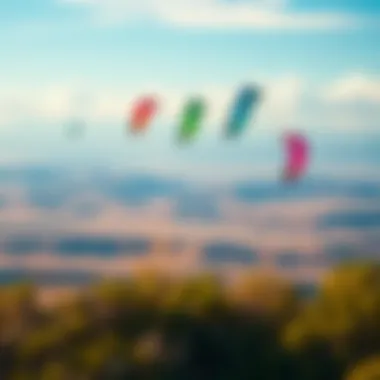

Intro
Land kite surfing is a sport that’s really catching on these days. Just like its cousin, kiteboarding, it offers the thrill of zipping across land, powered by the wind through a kite. But here’s the kicker: you can do it on a vast range of terrains, whether it’s flat fields, beaches, or hills. This guide aims to take you through all the essential bits and bobs about land kite surfing — the gear you need, handy techniques for both beginners and pros, and safety tips that are a must.
Gear and Equipment
When it comes to land kite surfing, having the right equipment can make all the difference between a memorable ride and a challenging experience. Let's break down what you need to get started.
Essential Kiteboarding Gear for Beginners
To start your land kite surfing journey, there are a few basic items that you should lean on. While there’s quite a bit to choose from, following this list can help ensure you have what you need:
- Kite: You’ll need a controllable kite. Opt for a traction kite, which is designed for power and control during land surfing. A good beginner kite is usually around 1.5 to 3 meters.
- Control Bar: This is your steering mechanism. It connects you with the kite, allowing you to maneuver it with ease.
- Harness: A comfortable harness is a necessity. This helps distribute the pull from the kite across your body, rather than just your arms, making it easier to control.
- Safety Leash: Always have a safety leash attached to your kite and harness. It’s an essential safety feature to keep the kite attached to you.
- Footwear: Depending on the surface terrain, sturdy shoes or boots provide protection. Whether you're on soft sand or rugged ground, you’ll want to keep your feet safe and stable.
Advanced Equipment for Experienced Riders
For those who are already riding the waves of experience, it’s time to consider gear that can sharpen your skills:
- High-Performance Kites: These kites are made for speed and agility. Look for options that are lightweight with a robust frame for quick response.
- Specialty Boards: As you get more advanced, you should think about boards designed specifically for land kiting, like a buggy or a mountain board that can handle rougher surfaces.
- Upgraded Harnesses: There are advanced harnesses available that offer additional support and comfort, and can make a considerable difference in prolonged sessions.
- Wind Meter: Keeping an eye on wind conditions is vital for experienced riders. A small portable wind meter can help you determine if conditions are optimal for your skill level.
Techniques and Tips
Navigating through the nuances of land kite surfing goes beyond just having the right gear. Mastering technique plays a critical role in your enjoyment and safety.
Safety Practices for Kiteboarding
Before you hit the ground running, it’s crucial to prioritize safety. Here are some tips:
- Assess the Environment: Always check the area for obstacles, other people, and terrain hazards. Wind conditions can change, and it’s best to avoid crowded spots.
- Know Your Limits: Start with lighter winds and gradually increase as you gain confidence. Pushing your limits can lead to accidents.
- Stay Aware of Weather: Keep an eye on weather patterns. Sudden gusts can turn a pleasant session into a hazardous one.
- Use Proper Signals: Always communicate with any riders or spectators around you. Hand signals or vocal calls can prevent accidents.
Training Techniques to Improve Your Skills
Improving your skills does not happen overnight. Here are some tips to help you refine your ride:
- Practice Ground Handling: Before you even attempt to ride, spend time just handling the kite on the ground. Learn how it reacts to different inputs.
- Take Lessons: There are plenty of local schools and instructors who can give you structured lessons. Learning from someone with experience can speed up your learning process.
- Join a Community: Connect with others who share your passion for land kite surfing. Online forums like Reddit or local clubs can provide support and valuable information.
"Join a community that encourages and challenges you. It enhances the learning experience."
By understanding all these facets of land kite surfing, you’ll not only enhance your skills but also maximize your enjoyment while riding the winds.
Preface to Land Kite Surfing
When it comes to wind-driven sports, land kite surfing stands out as an exhilarating option with a unique twist. This activity beats the conventional kiteboarding not only by allowing practitioners to glide over various terrains but also by offering a sense of freedom that greets those who dare to harness the power of the wind. This section brings to light its significance, focusing on the vital components and the immense potential for both enjoyment and skill development in the sphere of land kite surfing.
Definition and Concept
Land kite surfing, as its name suggests, combines the art of kite flying with the mobility of surfing, but done on solid ground like fields, parks, or beaches. It essentially involves propelling oneself on a board while being powered by a large kite. Think of it like riding a skateboard or rollerblading, except with the wind doing the heavy lifting. The excitement is palpable; it’s not just about moving fast, but also about mastering the wind, balancing correctly, and maneuvering in ways that feel seamless.
The basic components include a kite, a board, and safety equipment. Riders control their direction and speed primarily through the kite, which acts as both sail and steering apparatus. Land kite surfing offers a different thrill than its water-bound predecessor but carries similar principles—focus on balance, awareness of environmental elements, and the joy of mastering new techniques.
Brief History
The roots of land kite surfing can be traced back to a blend of traditional kite flying and different board sports that gained popularity in the late 20th century. First, in the late 1970s, people started experimenting with the synergy between kites and surfboards, initially skimming on water. It wasn’t too long before innovators realized that solid surfaces also provided excellent canvases for this kinetic artistry.
The early 1990s saw the introduction of countless innovations that shaped modern land kite surfing. Enthusiasts took to fields and sandy areas to build the culture surrounding this unique sport. However, as interest continued to grow, so did the technological advancements. New materials and designs allowed for better control, greater safety, and more fun. Riders now enjoy a greater range of kites specifically engineered for different terrains, catering to all skill levels. Today, land kite surfing is a global phenomenon, attracting adventurous souls from all corners of life, whether they’re seasoned kiteboarders or simply curious explorers.
Understanding the Gear
When diving into land kite surfing, understanding the gear is like knowing your way around a kitchen before cooking a feast. The right equipment not only enhances safety but also amplifies the fun and efficiency of your riding experience. From kites to boards, choosing the right gear can make all the difference between a successful ride and a frustrating tumble.
Kites: Types and Functions
Kites are, without a doubt, the heart and soul of land kite surfing. They come in various shapes and sizes, each designed to cater to different conditions, preferences, and skill levels. Two primary types dominate the landscape: foil kites and tube kites.
Foil Kites
Foil kites operate by utilizing internal cells to trap air, creating lift and allowing the kite to fly. One of the standout characteristics of foil kites is their lightweight design, which contributes to their efficiency in light wind conditions. They are often favored by riders who prefer a kite that performs well in a variety of scenarios, particularly in low wind.
A unique feature of foil kites is that they can be packed down quite small, making transport a breeze. However, they can be more challenging to relaunch than their tube counterparts, particularly if you find yourself in tricky winds. The trade-off is a kite that can handle diverse terrain with grace.
Tube Kites
In contrast, tube kites are equipped with inflatable tubes that maintain their shape, which helps them stay aloft even in gusty winds. Their key characteristic lies in their stable flight, which is crucial for beginners and those wanting to push their limits. Riders often find tube kites easier to launch and relaunch, reducing the hassle on land.
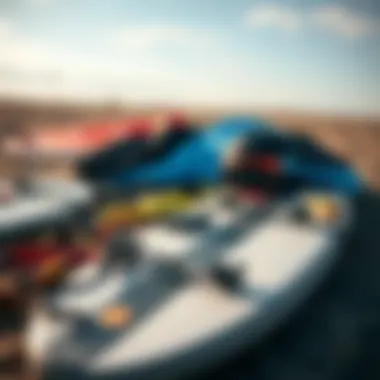
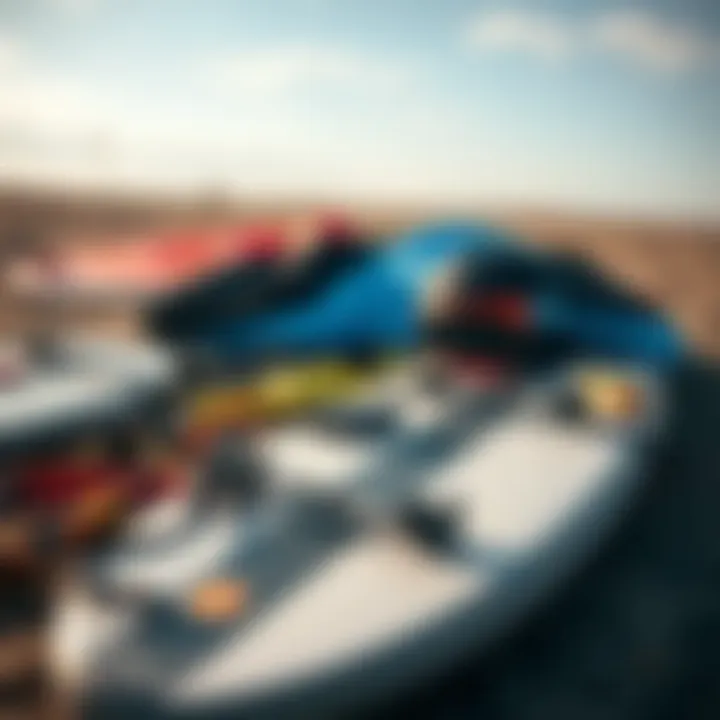
The strong point of tube kites is their performance in a wider range of wind conditions. The downside? They tend to be heavier, which might make them a challenge to handle in the higher wind speeds. Still, their versatility keeps them popular among many riders, especially in more challenging environments.
Boards and Other Equipment
Your board is essentially your connection to the ground while you’re flying high above it. While there are many choices out there, understanding how to select the right land board can enhance your kite surfing experience significantly.
Land Boards
Land boards are specifically designed for traveling across dirt, grass, or sand. One main feature is the larger, wider wheels that help distribute weight and provide stability when riding over uneven ground. This characteristic gives riders confidence, particularly those new to land kite surfing.
Land boards also offer different shapes and styles, allowing personal customization depending on riding style. Whether you prioritize speed or maneuverability, there’s a land board to match your needs. However, some boards can be on the heavier side, which could limit performance during jumps or tricks.
Harnesses
A harness is often an overlooked but essential piece of gear in the land kite surfing world. These devices come in various styles based on preference and usage. The main characteristic of harnesses is to distribute the pull of the kite across the body, minimizing fatigue as you ride.
Choosing the right harness can greatly influence your comfort and control while kite surfing. A well-fitted harness provides freedom of movement without compromising security, essential for performing tricks. However, a poorly fitted harness can lead to discomfort or even injury, so proper sizing is critical.
Safety Gear
Safety should never take a backseat in land kite surfing. The right safety gear—like helmets and protective pads—can be the difference between a thrill-filled ride and a trip to the hospital.
Helmets protect against head injuries and should be lightweight yet sturdy. They come in various styles, with some even tailored for specific conditions or tricks.
Protective pads, such as knee and elbow pads, can absorb shocks and scrapes. Investing in quality safety gear ensures that you can focus on the fun without fretting about the risks. Remember, a smart rider prioritizes safety to keep the adventure going!
"Adventure knows no bounds, but safety keeps you on the course."
Understanding these gear components not only elevates your riding experience but also builds a solid foundation as you advance your skills. The right equipment can enhance safety, unlock potential, and ultimately, increase the joy derived from land kite surfing.
Techniques for Beginners
Engaging in land kite surfing can seem a bit like trying to juggle while riding a unicycle. It requires a certain finesse and understanding of the dynamics involved. As much as the wind plays its part, having the right techniques firmly in hand can make the experience much smoother and vastly more enjoyable. For those just starting out, it's not just about learning how to control the kite; it’s about embracing the whole experience and soaking in every thrill the sport offers. This section dives into the foundational techniques that serve as the building blocks for all riders.
Basic Kite Control
Kite control is the bread and butter of land kite surfing. If you're not grasping how to handle your kite properly, you're throwing your chance of having a great day out the window. Think of the kite as an extension of yourself. Mastering the basics can significantly enhance maneuverability and safety. Beginners should familiarize themselves with the following:
- Understanding the Wind Window: This is crucial. The wind window is the area in which your kite can fly. It’s shaped like a large hemisphere above you. The positions within this window dictate how your kite will respond, so knowing the sweet spots is vital.
- Reel it in and Let it Fly: Learning to stabilize the kite both when it's up high and close to the ground is key. Bring the kite slowly across the wind window, and don’t be too aggressive. A gentle touch goes a long way.
- Feeling the Pull: As a kite surfer, you should be aware of the pressure on the lines. Being sensitive to this allows quick adjustments as the wind picks up or dies down.
Mastering these aspects can set you up for success, paving the way for more thrilling ventures.
Starting and Stopping
When you’re first starting out, knowing how to begin and halt your ride holds immense significance. Picture it like learning to drive: if you don’t get the car moving or can’t stop safely, it’s going to be a bumpy road. Here are the core elements to ensure a smooth start and a controlled stop:
- Positioning is Everything: As you prepare to start, align your board with the wind direction. The angle at which your board faces can determine the ease of your initial movement.
- Powering Up: Once you're ready to roll, fly the kite high into the wind window. This will generate the necessary pull. A sudden surge indicates you’re about to catch the wind – it's where the fun begins.
- Find the Balance: As you accelerate, keep your knees slightly bent. This makes it easier to adapt to sudden changes in speed or direction.
- Bringing it Down: To stop, steer the kite towards the edge of the wind window slowly. This action will decrease the pull, allowing you to come to a halt gradually.
Practicing these actions repetitively will help solidify your confidence and comfort on the board.
Turning and Maneuvering
Once you've grasped the basics of starting and stopping, you’ll want to dive into the world of turns and tricks. This aspect adds flair and dynamism to your rides. Not only does it enhance performance, but it cultivates a deeper connection with the kite and the elements:
- The Art of the Turn: To execute a proper turn, initiate by steering the kite in the direction you wish to go. It’s all about timing – the kite needs to be moved smoothly, while you lean in the desired direction. A common phrase here is "lean the way you want to go."
- Transitions: Learn how to shift from one direction to another fluidly. Flicking the kite across the wind window while adjusting the board position helps in executing seamless transitions.
- Applying Weight Shifts: Control involves not just steering but also shifting your weight. Leaning forward can increase speed, while shifting back helps absorb bumps and maintain balance.
Master these turning techniques, and you'll find yourself riding like a pro in no time!
As you develop your skills, practicing these techniques will become second nature. Learning how to control your kite, start and stop effectively, and navigate turns will not only boost your performance but also foster a deeper appreciation for the sport. Embrace the journey, and make the learning process a thrill of its own.
Advanced Techniques
When it comes to land kite surfing, moving beyond the basics is an exhilarating leap into a more dynamic and adrenaline-pumping experience. Advanced techniques not only boost your thrill factor but also greatly enhance your skill set, taking your riding to new heights—quite literally. Engaging in these advanced methods allows riders to harness the full potential of the kite and adapt to varying conditions with finesse. Mastering these techniques can open doors to complex maneuvers, boosting confidence, and improving performance.
Jumping and Tricks
Jumping and tricks are the bread and butter of any advanced land kite surfer's repertoire. The ability to leap into the air and perform tricks not only showcases your expertise but also adds a layer of excitement to your riding. Getting airborne can be achieved through the following:
- Harnessing Power: Knowing how to position your kite to catch wind efficiently allows for a smooth takeoff. Fly the kite higher as it generates lift, and as the kite reaches the zenith, shift your weight on the board for takeoff.
- Technique Matters: Use a strong knee bend to absorb the impact when airborne, and shifting your weight back ensures a softer landing. Tricks can include spins, backflips, and various grabs, turning rides into a performance.
- Practice and Patience: Landing tricks isn't as easy as pie. It often takes numerous attempts and repeated practice to nail them down.
"The jump can feel like an eternity, but it's fleeting. How you land dictates the ride ahead."
Speed Control Strategies
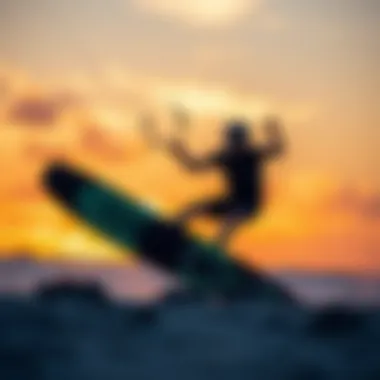
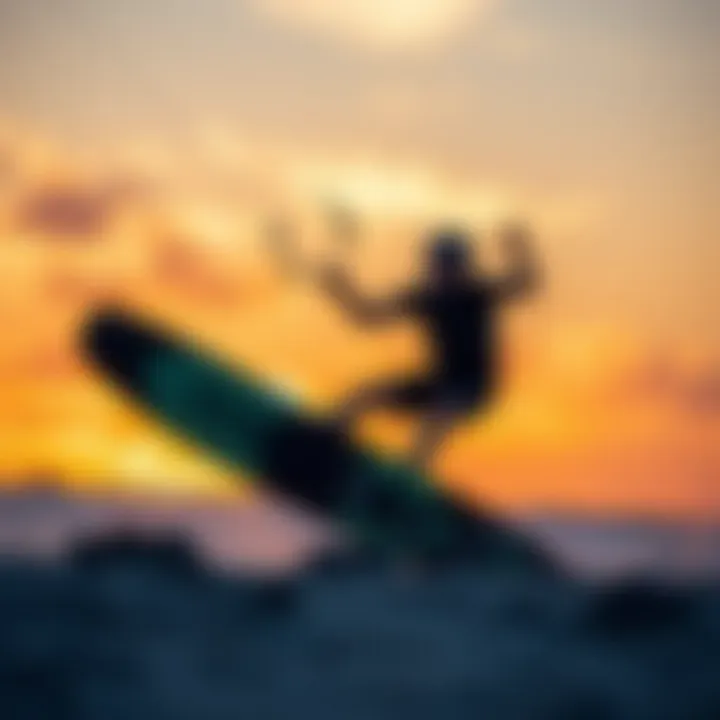
Gaining mastery over speed is paramount in land kite surfing. Knowing how to modulate speed not only affects maneuverability but also your safety. Beginner kitesurfers might find themselves overwhelmed by the gusty wind, leading to loss of control. Here's how to manage speed effectively:
- Body Positioning: Leaning back on the board while gradually pulling the brake can help slow down without toppling over, while a more forward stance allows for acceleration.
- Use of the Kite: Learn to steer the kite effectively. Flying it in a zigzag pattern will provide bursts of speed, while keeping it low can slow down your pace.
- Field Familiarity: Understanding the terrain you are riding on greatly helps in speed regulation. Flat open areas differ significantly from hilly terrains. Each requires different speed management approaches.
Wind Direction and Utilization
Recognizing and utilizing wind direction is crucial for succeeding in land kite surfing. Wind is your primary source of power, and understanding its nuances can drastically shift your experience:
- Identify Patterns: Different times of day can result in shifting wind patterns, often more consistent during afternoons.
- Directional Awareness: Always consider where the wind is blowing in relation to your riding zone. Finding the sweet spot where you can utilize crosswinds for the maximum effect can give you an advantage.
- Kite Angles: Positioning your kite at optimal angles against the wind can affect both lift and speed. Learning to adjust your kite’s angle in real-time is what differentiates seasoned surfers from novices.
In summary, mastering advanced techniques in land kite surfing not only elevates the sport but brings a sense of achievement and camaraderie within the community. You come to understand that kite surfing isn’t merely about riding; it's about finesse, strategy, and pushing your own boundaries.
Safety Considerations
Safety is paramount in any extreme sport, and land kite surfing stands as no exception. The exhilarating rush of harnessing the wind offers an amazing experience, but it also brings about risks that cannot be ignored. Understanding the safety measures is not just about protecting oneself; it enriches the journey and ensures that the thrill of riding does not come with unintended hazards.
Essential Safety Gear
Helmets
Helmets serve as a crucial layer of protection in land kite surfing. They are designed to minimize the impact on your head during falls or collisions, which can occur when the kite is in full swing. A proper helmet must fit snugly and should be lightweight to avoid discomfort while riding.
One key characteristic of helmets for land kite surfing is their aerodynamic design. This feature reduces drag, allowing riders to maintain speed without compromising safety. Popular models, like the Gath helmets, come with visors that provide protection against debris and harsh sunlight.
However, it’s essential to choose helmets specifically rated for action sports. Not all helmets are created equally. Some may look robust but lack the necessary safety certifications, which can be a gamble when riding at high speeds. The advantage of choosing high-quality helmets is compelling: they not only mitigate the chance of a serious head injury but also enhance your overall riding confidence.
Protective Pads
Protective pads are another cornerstone of safety gear in land kite surfing. Unlike helmets, which focus on the head, protective pads cover critical areas such as knees, elbows, and shins. They act as a buffer during hard landings or unexpected tumbles, reducing the risk of scrapes and bruises.
These pads often come with impact-resistant materials, making them a popular choice among riders. For instance, Pro-Tec usually offers pads with a hard shell and soft foam, providing both protection and comfort. They are designed to absorb impacts effectively, allowing beginners and seasoned riders alike to take risks while minimizing injury.
However, the downside could be the bulkiness. Some riders find that wearing pads can feel restrictive, especially during intense maneuvers. Each rider must weigh the balance of mobility versus protection and choose what fits their riding style.
Risk Management Strategies
Managing risks in land kite surfing involves understanding the potential hazards related to the wind, terrain, and one’s own capabilities. The best strategy includes thorough preparation and knowledge about the environment. Riders should always have an escape plan; knowing where to go if the winds pick up unexpectedly can save from a sticky situation.
It’s also wise to ride with a buddy when possible. Having someone alongside not only adds to the fun but also provides a level of safety. If something goes awry, an extra set of eyes can assist in assessing the situation. Also, maintaining a safe distance from obstacles—like trees, fences, or water bodies—can prevent accidents.
Weather Awareness
Riders need to develop a keen sense of weather patterns and changes. Wind conditions can vary dramatically even in short spans; being aware of these can be the difference between a great session and a risky disaster. Checking local weather forecasts and apps before gearing up is crucial.
Additionally, knowing how to read the signs in nature can enhance safety. For instance, if you notice the wind picking up and clouds gathering, it might be time to pack it in rather than risk it. A good guideline is to always have a backup plan, especially if the weather turns unfavorable.
"Understanding safety isn't just about avoiding danger; it’s about maximizing your experience on the land."
By following these safety considerations—from essential gear to weather awareness—land kite surfers can enjoy their adrenaline-packed rides while keeping associated risks at bay.
Choosing the Right Location
Selecting the right location for land kite surfing isn’t just a matter of convenience; it can profoundly influence your experience and safety. Whether you’re a greenhorn looking to catch your first gust or a seasoned pro seeking to push your limits, the terrain plays a crucial role. Specific elements, like terrain types and local regulations, will shape your adventure.
Ideal Terrain Types
Flat Areas
Flat areas serve as an excellent canvas for land kite surfing. Imagine a sprawling field or an open beach—these locations provide a stable and predictable environment. The key characteristic of flat areas lies in their uniformity, which offers riders a consistent surface to maneuver on.
These locations are beneficial for beginners, as they allow for easier navigation and less risk of obstacles. Imagine struggling to control your kite while dodging rocks or bushes! In flat terrains, the worst you'll deal with is a stray dandelion.
However, not all flat areas are created equal; unique features like closely trimmed grass or hard-packed dirt can enhance the experience, giving riders a sense of speed and control. Yet, keep in mind that if the surface is too soft, it can lead to slower speeds, which might dish out a less thrilling ride.
Hills and Dunes
On the flip side, hills and dunes introduce a different flavor to land kite surfing. These undulating landscapes create a mix of challenges and excitement. The key characteristic here is elevation, which can be both exhilarating and intimidating. Riding down a dune can provide incredible speed, making every descent a thrill ride.
What makes hills and dunes a popular choice is the variety in terrain. Riders can experience sharp drops, smooth glides, and everything in between. Such unique features tend to offer natural windfalls, thanks to the variable terrain, amplifying wind strength in certain areas.
But it’s not all sunshine and rainbows; riding on hills can be trickier for newcomers. The disadvantage lies in navigating slopes, which can sometimes lead to spills and tumbles. So, while they add zest to the ride, there's also an increased risk and necessity for greater skill.
Local Regulations and Considerations
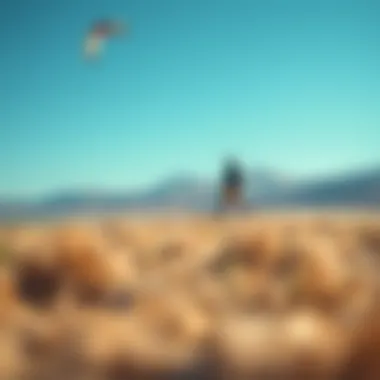
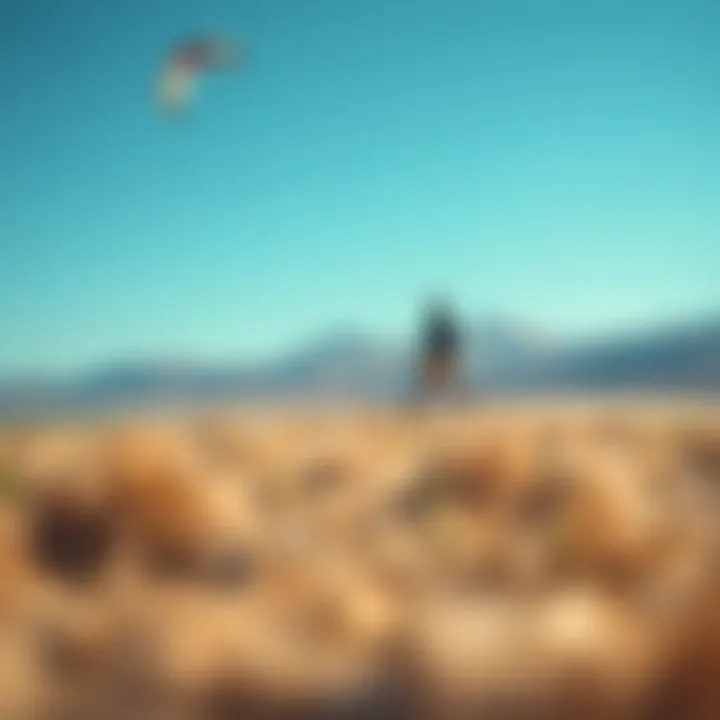
Before diving headfirst into your next land kite surfing escapade, it’s paramount to consider local regulations. Many locations have rules governing kite surfing to minimize safety hazards and preserve local wildlife. Engaging in this sport without understanding the law can lead to fines or even bans. Check local government websites or community forums, such as reditt.com/r/kitesurfing. Knowing where you stand legally can save you a heap of trouble and contribute to more harmonious relationships with local communities.
Weather Conditions and Seasons
Ultimately, weather conditions play a pivotal role in choosing the right location. Not all days are created equal for kite surfing; wind intensity and direction can vary significantly with seasons. For land kite surfing, steady winds range between 15 to 25 knots are ideal.
It's wise to check websites like windfinder.com or openweathermap.org for up-to-date conditions. Do yourself a favor—plan your outings around predictable seasonal changes, and you’ll often find yourself reaping the rewards in terms of both safety and enjoyment.
Remember: Always put safety first and consider your skill level when choosing your location. You might have that kite, but the wind and terrain dictate the ride. Don’t let a poor choice flip your adventure into a risky endeavor.
Community and Culture
Community and culture play a pivotal role in the landscape of land kite surfing. This sport, which thrives on the thrill of the wind and the adrenaline of speed, is not just about individual pursuits; it's deeply rooted in shared experiences and collective learning. Connecting with fellow riders fosters a sense of belonging and enhances the joy that comes with the sport. Through establishing ties with local kite enthusiasts, one not only sharpens their skills, but also nurtures friendships that can last a lifetime.
Benefits of a Strong Community
Engaging with other kite surfers presents a myriad of benefits:
- Skill Development: Seasoned kite surfers often share valuable tips and techniques that can help newcomers improve their abilities quickly. Watching and learning from others can significantly reduce the learning curve.
- Shared Resources: Communities often have resources like gear rental opportunities, repair workshops, and informal lessons that can help newcomers ease into the sport without hefty financial investment.
- Safety in Numbers: Kiteboarding can sometimes be risky, depending on the weather and location. When you’re part of a community, you’re not just gaining friends but also developing a safety network. It’s easier to manage hazards like sudden wind changes or tricky terrain when you have others nearby.
- Event Participation: Riding alongside others can lead to opportunities to participate in organized events. These events not only sharpen your skills but create memorable shared experiences.
Connecting with local riders thus comes with not only a bundle of benefits, but also enriches the experience of land kite surfing, transforming it from a solitary activity into a community-driven adventure.
Connecting with Local Riders
When one embarks on their land kite surfing journey, reaching out to local riders can be a game changer. Local communities can often be found through online platforms, such as Facebook groups dedicated to kite surfing, or even forums on sites like reddit.com where enthusiasts discuss everything from gear to favorite locations. Most regions have clubs, which often host regular meet-ups at popular local spots, turning the learning phase into a fun, social experience.
Moreover, local riders possess a treasure trove of knowledge about the terrain, weather patterns, and regional peculiarities. They can inform newcomers not just about the best times to surf, but also about hidden risks. As they say, "folks that know the ropes can save you from getting tangled!"
Events and Competitions
Participation in events and competitions adds an exciting layer to the land kite surfing culture. These occasions not only bring together riders from various skill levels but also showcase talent and passion for the sport. Many regions host annual competitions, such as local or regional championships, which can act as motivators for kite surfers to hone their skills and learn new tricks.
Additionally, these events often promote camaraderie among participants. Sharing the same passion for the wind and adrenaline can lead to profound connections, transforming competitors into friends.
- Types of Events:
- Why Participate?
- Race competitions, which focus on speed and precision.
- Freestyle events, highlighting creativity and skill in executing tricks.
- These competitions help riders evaluate their skills against others, fostering healthy competition and progression.
- Winning a prize or merely completing a race can boost one's confidence, inspiring further endeavors in the sport.
In Summary
Embracing the culture surrounding land kite surfing leads to personal growth, a deeper connection to the sport, and friendships that make the riding experience more rewarding. So, whether you’re smashing through the wind alone or alongside a vibrant group, remember—each session has the potential to turn into something special with the right community backing you.
Environmental Impacts
Land kite surfing, while exhilarating, holds a mirror to our connection with nature. As enthusiasts, it's essential to recognize the impact we have on the environments we frequent. Whether flying across vast fields, sandy dunes, or coastal landscapes, understanding these impacts can foster responsible practices and ensure that our beloved sport thrives alongside the ecosystems it engages.
Sustainable Practices
Sustainability in land kite surfing is about prioritizing the planet while indulging in our passion. The following practices help minimize our footprint:
- Choose Low-Impact Gear: Opt for kites and boards made from recycled materials or sustainably sourced components. Brands focusing on eco-friendly manufacturing not only contribute to less waste but also improve the overall sustainability of the sport.
- Respect Natural Areas: Stick to designated riding areas to protect flora and fauna. Venturing off can damage sensitive ecosystems. Always follow local regulations; these help preserve both the landscape and the sport itself.
- Leave No Trace: When landing, ensure no waste like wrappers, cans, or broken gear is left behind. Carry out what you carry in. It sounds simple, but this practice can significantly affect the environment.
"What you take from nature, it’s best to leave it as it is — back to nature."
- Educate and Involve Others: Share knowledge with fellow riders about environmental responsibility. Consider organizing clean-up events, engaging the community in preserving the locations we cherish.
Advocacy for Natural Areas
Advocating for our natural surroundings is not just a responsibility; it's a necessity. As kite surfers, we have a unique position to champion the preservation of the terrains we ride. Here’s how we can lend our voice:
- Partner With Local Conservation Groups: Collaborating with established organizations can amplify efforts. These groups often have the expertise and resources that can lead to significant environmental impact.
- Promote Awareness: Utilize social media platforms such as Facebook or Reddit to share stories of beautiful but endangered locations, urging fellow surfers to support protection measures.
- Participate in Local Meetings: Many communities hold public forums about land use and environmental protection. Attending these meetings lets you voice concerns and make informed recommendations on behalf of your sport.
- Be a Model for Future Generations: Engaging with younger surfers about the importance of nature conservation builds a culture committed to the environment's health. Sharing personal experiences and encouraging them to nurture the areas they enjoy guarantees a more eco-conscious future for land kite surfing.
In summary, land kite surfing can undoubtedly coexist with nature. By embracing sustainable practices and advocating for the preservation of natural areas, we can not only enjoy our sport but protect the very landscapes we navigate. The future lies in our hands, as stewards of both kites and the environment.
Culmination
The exploration of land kite surfing wraps around more than just the thrill of riding on various terrains. It dives deep into the heart of the sport, emphasizing both the joy and challenges it presents. As we’ve traversed through the intricacies of this exhilarating activity, a few key threads weave themselves into the very fabric of land kite surfing.
The Future of Land Kite Surfing
The evolution of land kite surfing is nothing short of remarkable. As technology advances, the sport adapts, making way for improved gear and safety equipment. The next few years may well see lighter, more durable materials being used in kites and boards, allowing for better control and agility. This could pave the way for a new generation of riders who can push the boundaries of the sport.
Furthermore, as more regions open up suitable terrains for this activity, the community is set to grow, lending itself to diverse riding styles and techniques. Nature parks and open fields are becoming prime locations. It is crucial for enthusiasts to remain vigilant and advocate for environmental sustainability as the sport expands.
Final Thoughts
In closing, land kite surfing stands at a fascinating crossroads between adventure and mindfulness. Riders embrace the power of nature while honing their skills, creating a profound connection with the outdoors. It is a community where sharing knowledge, participating in events, and fostering amicable relationships is vital. As participants, whether novice or expert, having a supportive network enhances the experience.
Ultimately, land kite surfing is more than just a hobby; it embodies a lifestyle of exploration, respect for nature, and constant growth. Striving for betterment and understanding the importance of sustainable practices ensures that this sport will be around for generations to come. Just remember, every time you hit the ground, it’s not just about the ride; it’s about nourishing a community that rides the wind together.



